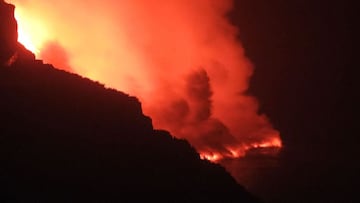Lava from La Palma volcanic eruption reaches the sea
Nine days after the volcano erupted on the Spanish Canary Island of La Palma, the lava finally reached the ocean on Tuesday, causing concern of toxic gases.

The volcanic eruption which occurred on September 19th is still causing destruction in the Spanish Canary Island of La Palma. The lava finally reached the sea on Tuesday night, nine days later. Where the lava touched the sea, the water was shallow and the contact with hot lava and cold saltwater caused a cloud of black smoke to form and blow upwards to the land.
The arrival of the lava in the sea has had authorities concerned from the start. Molten rock and saltwater react to create toxic clouds, which are extremely harmful to humans. In fact, the last time the Teneguía volcano erupted, there was only one death, and it was due to the person inhaling these toxic emissions. The four major risks with lava entering the ocean are collapsing lands and cliffs, waves of scalding lava rushing to the surface of the ocean, and small particles of glass blowing down from where the lava entered. The Civil Protection force has taken action to try and prevent any casualties and there is an exclusion zone set around the sea of two nautical miles.
When can residents return to normal?
Since the eruption, over 5,000 people have been evacuated, about 500 buildings have been destroyed, and 200 hectares of land have been demolished. It has officially been declared a disaster zone by the Spanish Cabinet and financial aid is in the works, as many residents lost their homes and possessions in the destruction.
When all of the commotion ends, residents will still have to deal with the aftermath before they're able to return to their lives on the island. It will need to cool off and the gas levels will need to be frequently checked to make sure it's safe.